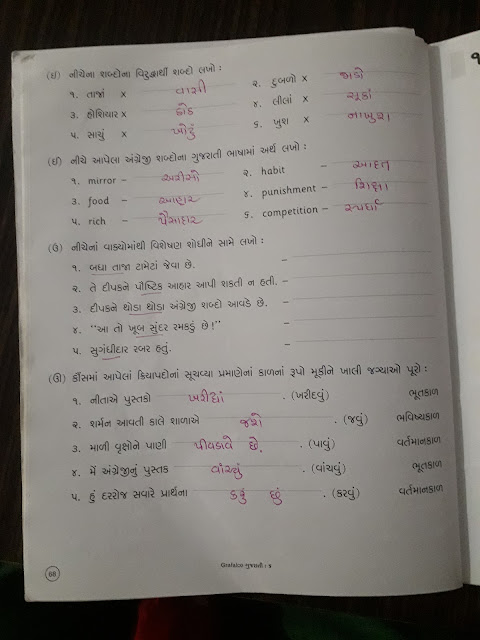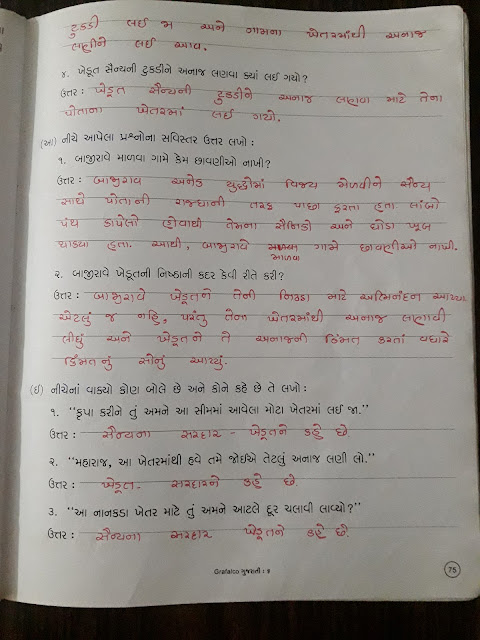हम में हैं कुछ खास, हम में हैं कुछ बात, क्योंकि हम ही हैं दुनिया की आस.
Thursday, January 27, 2022
Tuesday, January 18, 2022
SCIENCE CHAPTER 9B Living organisms and their surroundings WORKBOOK ANSWER
SCIENCE
CHAPTER 9B Living organisms and their surroundings
WORKBOOK ANSWER
1. Choose the correct option.
a) Which of the following is not the adaptation seen in frog?
i) can move on land ii) webbed feet
iii) strong back legs iv)presence of swim bladder Ans: presence of swim bladder
b) Which of the following aquatic animals do not have a streamlined body? i) squids ii) dolphin
iii) whale iv)fish
Ans: squids
2. State whether the following statements are true or false. Correct the false statement.
a) Snow leopards have thick fur on their feet and toes.
Ans: True
b) In hydrilla, roots are entirely absent.
Ans: False
Hydrilla has poorly developed roots.
c) Gills present in the fish help them to use oxygen dissolved in water. Ans: True
d) Long ears and eyes are located on the side of its head helps deer to live in the forests and grasslands.
Ans: True
3. Give two examples for each of the following.
a) Biotic components
Ans: plants / animals/ human beings/microorganism
b) Abiotic components
Ans: air/ water/ soil/ sunlight/ temperature
c) Terrestrial habitats
Ans: Desert /polar/ Grassland / rainforest
4. Assertion and Reason type questions:
In the following questions, two statements are given- one labelled Assertion (A) and the other labelled Reason (R). Read the statements carefully and choose the correct alternative (A), (B), (C) and (D) as given below.
(A) Both A and R are true and R is correct explanation of the assertion. (B) Both A and R are true but R is not the correct explanation of the assertion. (C) A is true but R is false.
(D) A is false but R is true.
a) Assertion: leaves of submerged plants can bend in flowing water Reason: submerged plants have narrow and thin ribbon-like leaves Ans: (A) Both A and R are true and R is correct explanation of the assertion.
b) Assertion: Thick layer of fat is one of adaptations of yaks.
Reason: A thick layer of fat beneath their skin helps in insulation against cold. ans: (A) Both A and R are true and R is correct explanation of the assertion.
5. Define the following:
a) Xerophytes
Ans: The land plants which live in conditions of water scarcity are known as xerophytes.
b) Hydrophytes
Ans: The aquatic plants that grow in fresh water ponds and lakes are called hydrophytes.
6. Answer the following questions in brief.
a) List the three different types of aquatic habitats? State one example of organisms found in each..
Ans: ∙ Marine habitat
Examples: sharks/ whales/ sea turtles / sea weeds
∙ Fresh water habitats
Examples: various types of fish, and water plants.
∙ Coastal habitats
Examples: crabs, oysters, seaweeds and mangroves.
b) . Enlist the adaptations seen in the plants growing in grassland habitat. Ans: ∙ The grasses growing here have flexible stalks so that they bend and do not break in windy conditions.
∙ They have strong roots to anchor the grass and small leaves to reduce loss of water.
∙ Trees growing here are also small, with small leaves and the roots go deep into the soil in search of water.
7. Give reasons for the following:
a) During the day time, Rats, snakes and other smaller animals living in dessert prefer staying in the burrows.
Ans: The burrows protect them from heat and loss of water from their body/to keep themselves away from intense heat.
b) The roots of aquatic plants are either absent or poorly developed. Ans: Due to abundant water absorbed directly by plants, the roots of aquatic plants become less significant. Therefore, these are either absent or poorly developed.
8. The diagram shows two potted plants: a cactus and a normal leafy plant kept in sunlight. Observe the diagram and answer the questions that follow.
Observe the given diagram of stomata and answer the questions that follow.
a) What will you observe in both the polythene bags after few hours?
Ans: Different amount of water collected in two polythene bags/ the polythene bag tied to the normal plant collects more water compared to cactus.
b) What can you conclude from above activity?
Ans: Desert plants lose very little water through transpiration.
9. Scientists estimate that about one million species of animals live in the ocean. Oceanic plants need to be able to find a stable place in the ocean in order to access sunlight to make food from photosynthesis. Oceanic plants are generally put into two categories: algae and seaweeds.
Phytoplankton and other types of algae float on the surface of the ocean. There's more sunlight at the surface of the ocean, so the ability to float freely is an advantage and considered an adaptation. And they can live in many different temperature and climate regions, which is also an adaptive advantage. https://study.com/academy/lesson/ocean-plant-adaptations-lesson-for-kids.html
a) List the two categories of oceanic plants.
Ans: algae and seaweeds
b) State the characteristic features of a phytoplankton that enables it to survive in water.
Ans: The ability to float freely helps them to access sunlight to make their food.
10. Given below is a picture of Saguaros and some words. Use the given words to fill in the blanks and complete the sentences on the Saguaro cactus. The saguaro cactus is one of the defining plants of the Sonoran Desert. These plants are large, tree-like columnar cacti. Saguaros are found exclusively in the Sonoran Desert. The most important factors for growth are water and temperature.
WAXY SURFACE
PREDATORS HOT
DRYRAIN
WATER
a) Sonoran Desert is hot and dry for most of the year.
b) A desert is a sandy and rocky place that receives so little rain. c) The saguaro cactus has spines; these help protect it from predators. d) The saguaro cactus has a strong waxy surface that helps it retain moisture during the hot days.
11.
HOTS
Why are the trees in the mountainous regions cone-shaped with sloping branches?
Ans: In mountain regions trees are normally cone shaped and have sloping branches because this helps the rainwater and snow to slide off easily.





















